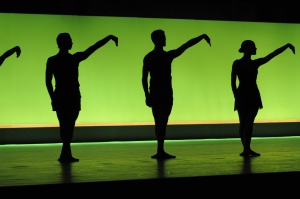
Hora, Batsheva Dance Company, 2009. Choreography: Ohad Naharin, courtesy of the artist. Image by Gadi Dagon.
Culture is a circle of art forms, each one part of the whole that defines us and makes us human. That is one reason the art of dance need be no stranger in a museum devoted to material culture.
And that is why Israel Museum director James Snyder introduced a new exhibition there, Out of the Circle: The Art of Dance in Israel, as “the intersection of dance and all the mediums that record dance: photography, documentary films, and graphic arts.”
Suddenly the circle, the most simple and perfect of forms, was bursting with meaning. Think of the hora, that basic folk dance, brought to Palestine from the Balkans. The Jewish pioneers—who had come to create a new Jew, physically strong and connected to the land—followed their days of hard labor with ecstatic circle dances. The circle was a great equalizer that drew the pioneers together and laid the foundations for the culture of the kibbutz, according to Talia Amar, the exhibition’s curator.
In the agricultural settlements, between the two world wars, dances were combined with rituals, shifting holiday observance from the synagogue to agricultural celebrations in the fields. This was actually the completion of a historical circle, for the Jewish holidays were originally agricultural festivals. Photographs of the kibbutz celebrations typically are shot from near the ground looking up, giving the dancers’ bodies mythic proportions.
Meanwhile, expressionist dance, which was popular in Europe in the 1920s and 1930s, caught on in Palestine, where it flourished and continued to develop long after it had waned in Europe. And Central European photographers who had come to Palestine, like Alfons Himmelreich, made this dance form their subject.
Some of these dancers sought local roots, which they found in biblical themes. And some turned to their own roots, like Sara Levi-Tanai, who drew on her Yemenite background. Levi-Tanai was the founder, choreographer, and artistic director of the Inbal Dance Theater—which Amar described as not a “folklore group” but rather “an art dance group” whose every movement had symbolic meaning.
As staged dance developed in Israel, the Batsheva Dance Company was founded by Baroness Batsheva de Rothschild and Martha Graham (and celebrated its 50th anniversary this year). The Suzanne Dellal Center for Dance and Theater, in Tel Aviv, whose director, Yair Vardi, initiated the Israel Museum exhibition, just celebrated its 25th anniversary.
The circle as a social ideal did not last, and the show’s title reflects that change. Works over the past few decades have shown the shift from the ideal of the collective to individualism; again and again, individuals try to break out of the circle, at great cost. The exhibition opens with a video of Ohad Naharin’s Anaphasa, danced to the Passover song “Ehad Mi Yodea” (Who knows one?), in which the individual who steps out of line keeps falling down.
In Peh Gadol (big mouth), by and with Niv Sheinfeld, Oren Laor, and Keren Levi, a woman dressed in the colors of the Israeli flag keeps falling out of step with the other two dancers, in a work that explores the tension between trying to remain part of the collective and exploring one’s individual identity.
Amar explained that the show “is not a historical exhibition encompassing the entire history of dance in Israel” but that it includes several major figures in that history.
Earphones synchronized with the main videos enable visitors to hear the music without disturbing others. Many of the other exhibits, however, contribute to a relatively high noise level in the hall.
Starting on December 23 and for the next ten weeks, dance performances showcasing contemporary Israeli choreographers will take place in the exhibition space and throughout the museum.
The exhibition runs through February 28, 2015.
Text copyright 2014 by Esther Hecht. No part of the text may be used without written permission of the author.